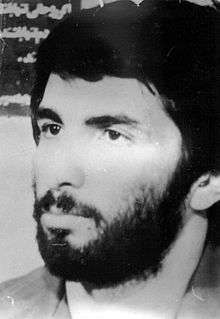Mohammad Jahanara
| Seyyed Mohammad Ali Jahan Ara | |
|---|---|
 | |
| Native name | سید محمد علی جهان آرا |
| Nickname(s) | Mohammad Jahanara |
| Born |
31 August 1954 Khorramshahr, Khuzestan, Iran |
| Died |
29 September 1981 Kahrizak, Tehran, Iran |
| Allegiance |
|
| Rank |
(Persian: سرلشکر) |
| Commands held |
|
| Battles/wars | |
Mohammad Ali Jahan Ara (Persian: محمد علی جهان آرا) also known as Mohammad Jahanara (Persian: محمد جهان آرا) was an Iranian commander of the Army of the Guardians of the Islamic Revolution and one of the main commanders in Battle of Khorramshahr in the Iran-Iraq War. He is a war hero and an icon of Iran-Iraq war. He also was one of the major commanders who fought against Arab separatists in 1979 Khuzestan uprising. Jahanara's commanded Revolutionary Guards and Iranian Navy Commandos (Takavaran) defended Iranian port city of Khorramshahr but after weeks of street fighting the city captured by Iraqis.[1][1] He is considered by Iranians as the symbol of Iranian resistance (Persian: نماد ایستادگی ایران). He and other commanders of Iran-Iraq war such as Valiollah Fallahi, Yousef Kolahdouz, Javad Fakouri, and Mousa Namjoo were killed in a plane incident when the Iranian Air Force Lockheed C-130 crashed, in the city of Kahrizak near Tehran.[2][3]
History

He was born on 31 August 1954 in Khoramshahr, Khozestan. When he was 15 years old, started his political and religious activities with some of his friends in Khoramshahr Imam Sadegh masque. In 1971, Mohammad and his brother joined the secret group of "Hezbollah", political campaign group against the Shah, Mohammad Reza Pahlavi, in Khoramshahr. 2 years later, members of Hezbollah group was identified and arrested by SAVAK, and Jahanara was sentenced to one year in prison.[2][4]
In 1975 (after graduating from high school), he went to the Tabriz School of Business and continued his political activities. On that time combat with weapons was important and for this reason, he joined the militant "Mansoron" group. Mohammad had vastly political activities in different cities such as Tehran, Kashan, Ghom, Yazd, and Isfahan. SAVAK killed his brother, Ali Jahanara, in 1978. In spring and summer of 1978, he was responsible for dispatching a group to Syria and Palestine for participated in a special militant training. Jahanara actively participated in the 1979 Revolution in his birthplace. After the victory of the Iranian Revolution and establishment of AGIR in 1980 and was selected as commander of Khoramshahr AGIR and established the Jihad of Construction (Persian:جهاد سازندگی) in Khoramshahr.[3][4] He got married with Akbarnejad in 1979.[5]
Battle of Khorramshahr
The Battle of Khorramshahr was a major engagement between Iraq and Iran in the Iran-Iraq War. The battle started from September 22 until November 10, 1980. Known for its brutality and violent conditions, the city came to be known by the Iranians as Khuninshahr, meaning "City of Blood". The Pasdaran commander, Mohammed Jahanara, was one of the last few soldiers to leave Khorramshahr when it fell to the Iraqis. He would go on to fight in the Siege of Abadan and lead Iranian forces to liberate Khorramshahr. He died before the city was liberated on May 24. A popular song was later written in his commemoration, saying, "Mamad, you weren't here to see that our city is liberated."[6]
Further reading
- Pedram Khosronejad (13 September 2013). Unburied Memories Politics Sacred Defense Martyrs Iran. Routledge. pp. 157–. ISBN 978-1-135-71160-3.
See also
- Battle of Khorramshahr
- Chess with the doomsday machine
- Eternal Fragrance (Last Sunday)
- Iran–Iraq War
- Liberation of Khorramshahr
- List of Iranian commanders in the Iran–Iraq War
- Noureddin, Son of Iran
- One Woman's War: Da (Mother)
- Ahmad Motevaselian
References
- 1 2 "Fall of Khorramshahr". Retrieved 25 October 1980. Check date values in:
|access-date=(help) - 1 2 "زندگینامه: محمد علی جهان آرا". hamshahrionline.ir. Retrieved 17 February 2015.
- 1 2 "سردار سرلشكر پاسدار شهید محمدعلی جهانآرا". tebyan.net. Retrieved 17 February 2015.
- 1 2 "زندگی نامه شهيد محمد علی جهان آرا". aviny.com. Retrieved 17 February 2015.
- ↑ "گفتگو با خانم اکبرنژاد, همسر سردار شهید سید محمد جهان آرا". hawzah.net. Retrieved 17 February 2015.
- ↑ McLaurin, R. D. (July 1982). "Military Operations in the Gulf War: The Battle of Khorramshahr" (PDF). U.S. Army Human Engineering Laboratory: 24. Retrieved 25 August 2012.